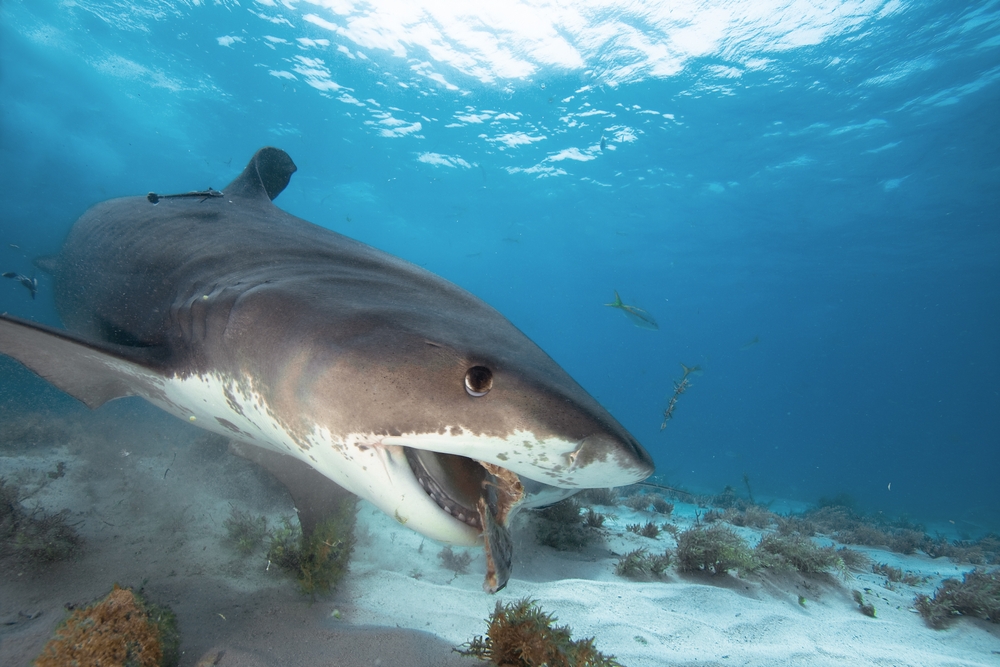In 2023, there was a warning that sharks off the coast of Florida could be chowing down on bales of cocaine deposited by traffickers.
Then, a high-profile experiment showcased during Shark Week tested out this warning. Hitting the headlines, the possibility of cocaine-fueled sharks became a hot topic. Despite the ensuing furor, this supposed problem remains highly skeptical.
“The experiments that were done for the TV show were really just to show people that there’s a connection between our impacts and wildlife,” says Tracy Fanara, an environmental engineer based in Florida who was part of the original experiment. “The truth is we don’t know how a shark would actually react to cocaine.”
What is known, however, is that packages of cocaine are deposited off the coast of Florida en masse, with many thousands of dollars’ worth eventually washing up on shore each year. The opportunity for sharks to encounter them, at least, is possible.
Is Cocaine Pollution a Danger?
Fanara says that the tests in the show were inconclusive. Researchers didn’t throw cocaine, but instead used bales of a stimulant that could cause a similar effect. Her research partner did witness a few sharks take a curious bite and respond erratically.
In the wake of the Shark Week test, other experts disagreed with the idea that these marine predators would actually bite into a bale unless it smelt of meat and questioned whether this issue even constitutes a real concern.
Since the show aired, Fanara has conducted further research around the topic to find out more; ultimately, she believes that cocaine bales could be a point source of cocaine pollution but is still uncertain.
Read More: A Scientific Mission To Save The Sharks
Sharks Biting Bales of Cocaine
A preliminary test was conducted to understand if wave action could break open a cocaine bale — the findings suggested it could. She also modelled tidal currents to see if deposited bales could crossover with the path of sharks.
Again, this suggested they could, but these findings are based on a very limited number of satellite-tagged sharks. Even if a bale were to break open, or a shark were to bite into one, the dilution effect of the surrounding water likely means that total exposure would be minimal.
“On top of that, we don’t know if the shark would actually go crazy, slow down, or even die,” she says, pointing out that several studies on other aquatic species, such as eels, do show effects after exposure to environmental concentrations of cocaine, but that may change and differ depending on a number of factors and the animal in question.
They would have to see multiple sharks bite into a bale of cocaine and record their responses, she added, stating that organizing such an experiment is problematic.
Read More: Animals That Have Gotten High or Drunk
Cocaine and Other Pollutants in the Ocean
Beyond the catchy headline and potential concern of how a shark exposed to cocaine might react, the fundamental problem Fanara sought to highlight is that ocean life is under pressure from a number of pollutants on a regular basis like illegal narcotics, caffeine, pharmaceuticals, human waste, and plastics.
Cocaine doesn’t just find its way into the oceans via bales thrown from boats or planes, but from wastewater discharges along with a host of other chemicals and potential toxins. Even high levels of water treatment can’t remove many of these pollutants entirely.
Conducting blood tests on sharks and other species could shed some light on exposure, Fanara adds. Such samples have been extracted from sharks for some time but when it comes to shark behavior in response to chemical exposure, field tests are unlikely to be conclusive. That said, researchers have found a host of pollutants in a number of shark species.
Read More: These 5 Animals Trip on Psychedelic and Psychoactive Drugs, Too
Sharks Ingesting Cocaine
In fact, in a recently published study a team of Brazilian researchers found cocaine and its metabolite, benzoylecgonine, in Brazilian Sharpnose sharks off the coast of Rio De Janeiro; prompting yet more cocaine shark references.
This species spends its entire life cycle in coastal habitats and thus is particularly vulnerable to pollution from land. All 13 of the sharks sampled tested positive for cocaine and 12 of them tested positive for benzoylecgonine, according to the study.
“It’s very possible and probable that sharks in the Florida Keys interact with some concentration of cocaine too. Is it enough to actually have a response and are they exposed to it consistently enough for long term impacts?” Fanara says, adding that other longer-lasting pollutants are likely more of a concern than the drug itself.
Read More: Almost 20 Million Years Ago, Sharks Nearly Went Extinct — Nobody Knows Why
Investigating Other Pollutants
Yet, that concern over coastal pollution has come to a head with the ongoing mass die off of endangered small-tooth sawfish in the Florida Keys. Researchers are uncertain what is causing this species, and numerous others, to first begin spinning erratically in the water, then die and wash up onshore.
But, as Fanara says, “although the leading hypothesis is a biotoxin, it’s possible that pollutants and other factors are compounding impacts.” Scientists are continuing to investigate this problem.
“Right now, we’re seeing the drastic impacts of chemicals in the water on our wildlife and it’s raising a lot of questions,” she says. “The changes we are making to the physics and chemistry of our coastal environments are posing ecological problems.”
It remains highly likely that the problem of a crazed cocaine shark that hit the big screen remains in fiction only, but what this wider pollution problem means for these species, their health, and wider ecosystems is a very real question. There’s definitely more work to be done, says Fanara.
Read More: How to Respond to Stranded Marine Life
Article Sources
Our writers at Discovermagazine.com use peer-reviewed studies and high-quality sources for our articles, and our editors review for scientific accuracy and editorial standards. Review the sources used below for this article:
Sean Mowbray is a freelance writer based in Scotland. He covers the environment, archaeology, and general science topics. His work has also appeared in outlets such as Mongabay, New Scientist, Hakai Magazine, Ancient History Magazine, and others.




















Discussion about this post